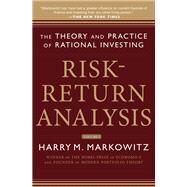Risk-Return Analysis Volume 3
, by Markowitz, Harry- ISBN: 9780071818315 | 0071818316
- Cover: Hardcover
- Copyright: 4/15/2020
The Rational Decision Maker
Words of Wisdom
John von Neumann
Acknowledgments
13. Predecessors
Introduction
René Descartes
There Is No “Is,” Only “Was” and “Will Be”
Working Hypotheses
RDM Reasoning
David Hume
Eudaimonia
Financial Economic Discoveries
Economic Analyses That Have Stood
the Test of Time
Constructive Skepticism
Isaac Newton, Philosopher
Fields Other Than Physics
Karl Popper
Mysticism
Caveats
Charles Peirce
Immanuel Kant
What an RDM Can Know A Priori
14. Deduction First Principles
Introduction
The Great Debate
One More Reason for Studying
Cantor’s Set Theory
“Very Few Understood It”
Finite Cardinal Arithmetic
Relative Sizes of Finite Sets
Finite Ordinal Arithmetic
Standard Ordered Sets (SOSs)
Finite Cardinal and Ordinal Numbers
Cantor (101)
Theorem
Proof
Corollary
Proof
Transfinite Cardinal Numbers
The Continuum Hypothesis
Transfinite Cardinal Arithmetic
Lemma
Transfinite Ordinal Numbers
Examples of Well-Ordered and
Not Well-Ordered Sets
Transfinite Ordinal Arithmetic
Extended SOSs
Lemma
Proof
The Paradoxes (a.k.a. Antimonies)
Three Directions
From Aristotle to Hume to Hilbert
British Empiricism versus Continental
Rationalism
Who Created What?
Cantor Reconsidered
Brouwer’s Objections
Axiomatic Set Theory
Peano’s Axioms (PAs)
Hilbert’s Programs
Whitehead and Russell
Zermelo’s Axioms
The “Axiom of Choice”
The Trichotomy Equivalent to the Axiom of Choice
Kurt Gödel (1906–1978)
Thoralf Skolem (1887–1863)
15. Logic is Programming is Logic
Introduction
Terminology
Number Systems and the EAS Structures
Built on Them
Deductive Systems as Programming Languages
A Variety of Deductive DSSs
Alternative Rules of Inference
“Ladders” and “Fire Escapes”
Organon 2000: From Ancient Greek
to “Symbolic Logic”
So, What’s New?
Immediate Consequences
Two Types of Set Ownership
Modeling Modeling
EAS-E Deduction: Status
16. The Infinite and The Infinitesimal
Points and Lines
Fields
Constructing the Infinitesimals
Infinite-Dimensional Utility Analysis
The Algebraic Structure Called “A Field”
17. Induction Theory
Introduction
The Story Thus Far
Concepts
Basic Relationships
Examples
“Objective” Probability
The Formal M59 Model
Initial Consequences
Bayes’s Rule
A Bayesian View of MVA
Judgment, Approximation and Axiom III
(1) A Philosophical Difference between
S54 and M59
Examples of Clearly “Objective” Probabilities”
Propositions about Propositions
A Problem with Axiom II
Are the pj
Probabilities the Scaling of the pj
?
The pj
“Mix on a Par” with Objective Probabilities
18. Induction Practice
Introduction
R. A. Fisher and Neyman-Pearson Hypothesis Tests
The Likelihood Principle
Andrei Kolmogorov
A Model of Models
The R.A. Fisher Argument
Bayesian Conjugate Prior Procedures
19. Eudaimonia
Review
Eudaimonia for the Masses
Notes
References
Index
The New copy of this book will include any supplemental materials advertised. Please check the title of the book to determine if it should include any access cards, study guides, lab manuals, CDs, etc.
The Used, Rental and eBook copies of this book are not guaranteed to include any supplemental materials. Typically, only the book itself is included. This is true even if the title states it includes any access cards, study guides, lab manuals, CDs, etc.
Digital License
You are licensing a digital product for a set duration. Durations are set forth in the product description, with "Lifetime" typically meaning five (5) years of online access and permanent download to a supported device. All licenses are non-transferable.
More details can be found here.






